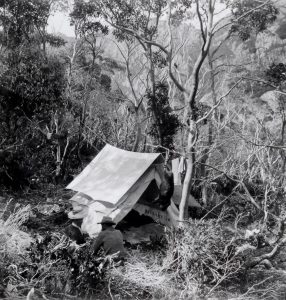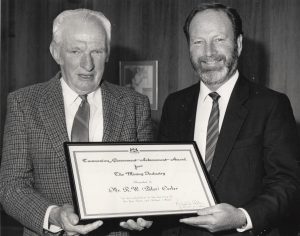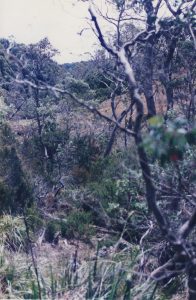The old man’s voice sounds cultured but distinctly Australian, like an interwar ABC news reader. It is the voice of a man who grew up in a British colony and is still slightly wearied by fighting for the Empire at Gallipoli and in France. However, the place that affected Major Ron Smith (1881–1969) most was Cradle Mountain, and he never lost contact with it after his first visit in 1907. In 1961 and 1962, at a time when the 80-year-old still puttered his old Chevrolet from Latrobe up to his Mount Kate House at Cradle Valley, he recorded some of his meticulous early high country hiking accounts on a reel-to-reel tape. Listening to the tapes, you could almost be with him in his lounge room at Percival Street, Latrobe. Every fifteen minutes his grandfather clock chimes in, Big Ben reviving a bygone age. Occasionally the old man stumbles over words penned half a century earlier, but his reading voice is resolute.[1]

The most remarkable account recorded by Smith on those tapes was that of his 1909–10 expedition to Cradle Mountain with Gustav and Kate Weindorfer and Walter Malcolm (WM) Black.[2] This is where the Weindorfer legend begins. The declaration on the mount (‘This must be a park for the people …’) and the selection of the site of Waldheim are almost biblical events for some Cradle Mountaineers, but for Smith they seem to have been quite matter-of-fact.

Getting to Cradle was just as interesting as being there. The Weindorfers and Smith set out from Roland Lea, Kindred, on 28 December 1909, the couple with the party’s luggage in a chaise wagon, Smith on a bicycle. As usual, Smith was equipped with a cyclometer which measured the distance covered by his wheels, an aneroid barometer which measured height above sea level, a prismatic compass, a Stereo Hawkeye roll film camera and a .38 Smith and Wesson revolver, with which he silenced any overhead flapping. Weindorfer didn’t hold with .38 Smith and Wesson. He was packing the larger calibre .44. The wombat that is recalled by the names Wombat Pool and Wombat Hill at Cradle might have died slowly of lead poisoning had these two not been able to finish it off in its burrow.[3]
Smith was an avid chronicler of people, places, heights and times. His most intriguing photo from the 1909–10 trip was the Fury Hut, at Fleece Creek, taken at 8.45 am on 3 January 1910, as the party departed for their next campsite at Crater Creek. The height above sea level was 2780 feet (847 metres) and it was sunny.
Fury Hut was the party’s second staging post, having been guided there from their first, Middlesex Station, by Wilmot hunter/prospector Tom Perry. Splitting their tents and provisions between two horses, they climbed over the divide between the Forth and Pieman River systems, then called Hounslow Heath, arriving at the Fury Hut after a four-hour trek. The well-built, one-room paling hut situated among pencil pines on the bank of Fleece Creek was not a holiday home.[4] It was a miners’ hut. Trenches and a shaft sunk in the nearby bank confirmed as much, while the cliff face above the hut site bears a tell-tale abundance of pick marks today. In January 1908 Perry’s mate, the Middlesex stockman Frank Brown, had taken out a ‘reward’ claim here.[5] The mineral was galena (lead sulphide), occurring with a little silver sulphide.

The Fury Hut and the Fury Mine or Show owed their name to a case of mistaken identity. Some bushmen called Fleece Creek the Fury River. They knew the mountain above it—officially the Heap of Rocks—as Mount Remus. The Fury River and Mount Remus were actually far more impressive features 10 or 15 kilometres to the south-west. The official Fury River could swallow dozens of Fleece Creeks in the deep chasm by which it disgorges the waters of Cradle Mountain into the Pieman system. Henry Hellyer’s descent of its 200-metre high walls during his nightmarish 1828 Mackintosh River exploration took four hours.[6]
Who built the Fury Hut is uncertain. Weindorfer and Smith ascribed it to Walter Black, who had joined Perry, Brown and Charlie Davey in working the narrow galena veins.[7] However, the evidence for Black as a hut builder is not compelling. He had employed two Middlesex stockmen, Brown and George Francis, to renovate his own hut at the Black Bluff Gold Mine: perhaps Frank Brown was the ‘go to’ builder.[8] Tom Perry had an ‘old’ camp nearby: this is likely to have been the original hut in the area.[9]
After Weindorfer settled at Waldheim Chalet in 1912, he joined with Brown in preparing to float a company to open up the Fury Mine. Working with others in 1914–15, they engaged visiting geologist and mining surveyor WH Cundy, who recommended first proving the lode cut in the shaft.[10] In 1916 Weindorfer named the mine as a potential beneficiary while speaking in favour of extending the Roland Branch Railway across the Forth River to Wilmot, and in the following year he recorded dolefully in his diary: ‘Spent miserable night without blanket in Fury hut. Pumped out the shaft with Jim [Rowlands]’.[11]

Mines. Advocate photo courtesy of the late Peter Cater.
The railway was never extended to Wilmot. Tom Perry married and moved away, WM Black went to war, Frank Brown left Middlesex Station, Weindorfer lost interest in the Fury Show, and little attention was paid to it until Maf Carter and his sons took it up as Carter’s Prospect in the 1960s. The Carters induced Aberfoyle, then operating the Cleveland Tin and Tungsten Mine, to option the mine, and over the next fourteen years lead and zinc anomalies in the area were explored without success.[12] At least two large excavations remain from this period.

The Fury Hut was probably gone by then. I first visited the Fury Mine in January 1995 with bushwalker David Duff. It was apparent from Ron Smith’s description of the site of the hut that it was on the southern bank of the stream near the four-wheel-drive track crossing. The clue to finding the site was a ridge line in the background of his 1910 photo. David and I lined up that ridge line while walking along the edge of the stream but did not venture far enough.

Returning to the southern bank of Fleece Creek in November 2018, Peter Brown, Ian Hayes, Tom Lawrence and I followed an old foot track along the bank beneath the cliffs. There was no relatively flat ground available for a hut site there, but as we proceeded further along the overgrown track the ground beneath the cliff widened out. A chimney butt then came into view. The site (about 5 x 2.8 metres) was benched into the hillside with a platform of flat stones helping to level it out and provide a bedding for the foundations of the hut. Small pencil pines growing out of the site had perhaps germinated in a fire which destroyed the hut. It became apparent that the ‘rock’ which appears in the foreground of Smith’s old photo was actually a sugar bag or gunny sack prepared for departure. The creek was close enough for easy water provision without ever threatening to flood the hut. Pencil pines cut on the opposite bank of Fleece Creek would have provided the boards and shingles.

On a previous trip in April 2018, Ian and Tom had found a large chopped stump with a shoe mark not far away, on the edge of the Penguin-Cradle Trail, a sure sign of a bushman cutting timber for a hut. Returning to that site seven months later, we found adjacent creek workings and a modern-day excavator trench. Our expectations of finding a hut site now increased. Tom found the hut platform scattered with broken bottles between the creek and the Penguin-Cradle Trail. It measured about 7 x 3 metres, with a well-formed hearth and a bedding of stones. The only other hut we knew about in the approximate area was Tom Perry’s: could this be it?

Tom Perry was Thomas William Perry (1869–1928), eldest son of Wilmot settler Harry Perry and his first wife Harriett Forster.[13] In 1910 he was even listed next to Brown and Black in Wise’s Tasmanian Post Office Directory as a ‘miner’ residing at Middlesex Plains.[14] Ron Smith and Gustav Weindorfer visited Perry’s ‘old camp’ on new year’s day in 1910. Proceeding ‘a good way’ up Fleece Creek from the Fury Hut, they turned up onto Hounslow Heath and went north-west to the edge of the forest to the hut. Unfortunately Smith did not describe the building, but he did record that it was only ten minutes’ walk from Fury Hut by the most direct route. The closeness of the two huts was confirmed when, next evening, WM Black arrived at the Fury Hut just after sunset, and after dining with the party, left to sleep at Perry’s Camp, apparently confident of reaching it in the twilight or by moonlight.[15]
The hut site discovered by Tom Lawrence in November 2018 was within 400 metres of Fury Hut as the crow flew, a distance that could certainly be covered in ten minutes with a clear route. Given the adjacent digging in the creek, this is likely to have been Perry’s original hut on the original Fury diggings. There is no sign today of a second building such as a skin shed, but Middlesex hunters often used a large wooden chimney to peg out their skins and dry them close to the fire.
Day trips don’t get much better than this. Rediscovering two historic hut sites in a day makes up for plenty of previous bush floundering. Only Ron Smith’s meticulous accounting made this rediscovery possible more than a century later. Every one of his expedition records brings the past to life for those who want to go out and find it.
Nic Haygarth 2019
Copyright Mountainstories.net.au
[1] Thanks to Eddie Firth for lending his CDs of the Ron Smith tapes.
[2] For the Weindorfers see Nic Haygarth, ‘Gustav Weindorfer, king of the Cradle’, in Simon Cubit and Nic Haygarth, Mountain men: stories from the Tasmanian high country, Forty South, Hobart, 2015, pp.56–83.
For Black see Nic Haygarth, ‘The rain on the plain falls mainly outside the gauge, or how a black sheep brought meteorology to Middlesex’, http://nichaygarth.com/index.php/2016/10/10/the-rain-on-the-plain-falls-mainly-outside-the-gauge-or-how-a-black-sheep-brought-meteorology-to-middlesex/, accessed 14 December 2018.
[3] Ron Smith, ‘Trip to Cradle Mountain: Mr and Mrs Weindorfer and RE Smith’, 28 December 1909 and 5 January 1910.
[4] Ron Smith, ‘Trip to Cradle Mountain: Mr and Mrs Weindorfer and RE Smith’, 31 December 1909.
[5] See ‘Reward claims’, AA857/1/1 (TAHO). A reward claim is a lease issued with a peppercorn rental as a reward for making the first discovery of a particular mineral in the district.
[6] CJ Binks, Explorers of western Tasmania, Mary Fisher Bookshop, Launceston, 1980, pp.96–98.
[7] Smith’s photo caption; ‘A Gnome’ (Gustav Weindorfer), ‘Holidays in the Cradle Mountains’, Weekly Courier, 22 September 1910, p.37.
[8] The evidence for this is an RE Smith photo taken of the Black Bluff gold mine hut renovation in 1905.[9] Ron Smith, ‘Trip to Cradle Mountain: Mr and Mrs Weindorfer and RE Smith’, 1 January 1910.
[10] See letters Crawford to Gustav Weindorfer, 24 August 1914, 10 December 1914, 15 December 1914, 6 January 1915 and 21 January 1915, NS234/12/3 (TAHO).
[11] ‘Evidence at Wilmot’, North Western Advocate and the Emu Bay Times, 15 January 1916, p.7; Gustav Weindorfer diary, 17 February 1917, NS234/27/1/7 (TAHO). Jim Rowlands was Wilmot farmer Bob Quaile’s manager at his highland stock run, Daisy Dell.
[12] See, for example, Gerhard Krummei, ‘Progress report on the Back Creek prospect, Mackintosh area, Tasmania’, May 1970; or John Pemberton and John Simpson, ‘Progress report on Heap of Rocks, EL46/80, Tasmania’, July 1983, Mineral Resources Tasmania website, http://www.mrt.tas.gov.au/portal/document-search, accessed 2 December 2018.
[13] Birth registered at Port Sorell to then Sassafras farmer Harry Perry and Harriett Forster, 20 July 1869, birth registration no.1311/1869, RGD33/1/47 (TAHO); ‘Forth’, Advocate, 24 May 1921, p.5; Leonard C Fisher, Wilmot: those were the days, the author, Devonport, 1990, p.160. In 1912 Perry married Amelia Aderline Christina Brown, who is likely to have been Frank Brown’s niece (marriage registration no.0960/1912 [TAHO]). He is recalled by Perrys Peak on the eastern side of the Dove River near Cradle Valley (RE Smith, ‘Cradle Mountain: names in the reserve’, Mercury, 7 December 1935, p.18). According to research by Amanda Dent, Tom Perry died at Goulburn, New South Wales, on 16 April 1928, aged 58.
[14] Wise’s Tasmanian Post Office Directory, 1910, p.188.
[15] Ron Smith, ‘Trip to Cradle Mountain: Mr and Mrs Weindorfer and RE Smith’, 2 January 1910.